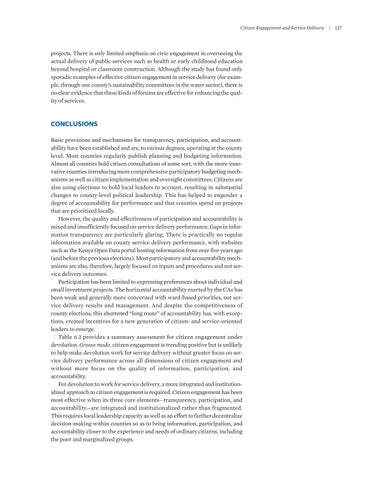Citizen Engagement and Service Delivery
projects. There is only limited emphasis on civic engagement in overseeing the actual delivery of public services such as health or early childhood education beyond hospital or classroom construction. Although the study has found only sporadic examples of effective citizen engagement in service delivery (for example, through one county’s sustainability committees in the water sector), there is no clear evidence that these kinds of forums are effective for enhancing the quality of services.
CONCLUSIONS Basic provisions and mechanisms for transparency, participation, and accountability have been established and are, to various degrees, operating at the county level. Most counties regularly publish planning and budgeting information. Almost all counties hold citizen consultations of some sort, with the more-innovative counties introducing more comprehensive participatory budgeting mechanisms as well as citizen implementation and oversight committees. Citizens are also using elections to hold local leaders to account, resulting in substantial changes to county-level political leadership. This has helped to engender a degree of accountability for performance and that counties spend on projects that are prioritized locally. However, the quality and effectiveness of participation and accountability is mixed and insufficiently focused on service delivery performance. Gaps in information transparency are particularly glaring. There is practically no regular information available on county service delivery performance, with websites such as the Kenya Open Data portal hosting information from over five years ago (and before the previous elections). Most participatory and accountability mechanisms are also, therefore, largely focused on inputs and procedures and not service delivery outcomes. Participation has been limited to expressing preferences about individual and small investment projects. The horizontal accountability exerted by the CAs has been weak and generally more concerned with ward-based priorities, not service delivery results and management. And despite the competitiveness of county elections, this shortened “long route” of accountability has, with exceptions, created incentives for a new generation of citizen- and service-oriented leaders to emerge. Table 6.3 provides a summary assessment for citizen engagement under devolution. Grosso modo, citizen engagement is trending positive but is unlikely to help make devolution work for service delivery without greater focus on service delivery performance across all dimensions of citizen engagement and without more focus on the quality of information, participation, and accountability. For devolution to work for service delivery, a more integrated and institutionalized approach to citizen engagement is required. Citizen engagement has been most effective when its three core elements—transparency, participation, and accountability—are integrated and institutionalized rather than fragmented. This requires local leadership capacity as well as an effort to further decentralize decision-making within counties so as to bring information, participation, and accountability closer to the experience and needs of ordinary citizens, including the poor and marginalized groups.
|
127


